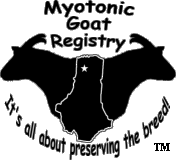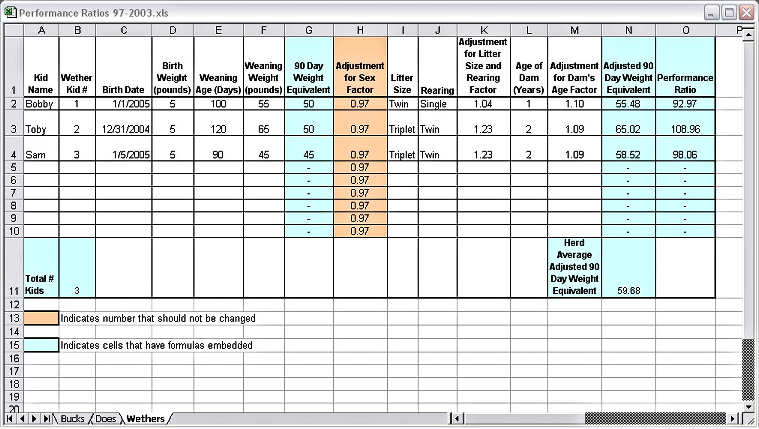Understanding
Performance Ratios
By:
Cindy Bene
Moonlight
Farms
A printer friendly version of this article and an instruction sheet along with an Excel
spreadsheet template can be downloaded, as a .zip file, at our breeders
downloads section.
The purpose of using Performance Ratios is to identify
animals that are "above average" in each kidding season.
They are also helpful in ascertaining which females are the
better producers.
When calculating Performance Ratios,
animals must be compared to their own contemporary group versus animals
from another breeder or farm. This ensures that the animals
being compared were all born and raised under the same conditions and
management. Additionally, bucks, does and wethers are
calculated as separate groups.
The simplified formula for the
calculation of the Performance Ratio is:
Individual animal's weaning weight divided by the contemporary
group average weaning weight, and then multiplied by 100. Since
this is a ratio, a score above 100 is considered "above average".
Before this calculation is done, however, the weaning
weights are first adjusted to 90 day weight equivalents. Most
kids are weaned between 60-120 days. Regardless of when the
kid is weaned, in order to draw meaningful comparisons, all kids'
weights in the group are adjusted to the 90 day weight equivalent
as follows:
-
Subtract
birth weight from weaning day weight
-
Divide
by age (in days) at weaning
-
Multiply
by 90
-
Add
to birth weight to get the 90 day weaning weight
Example: A kid weighed 5
pounds at birth and 55 pounds when weaned at day 100.
Step 1: Calculate the
average daily weight gain
Step 2: Convert above to 90
day weaning weight:
-
0.5
multiplied by 90 = 45 pounds
-
45 plus the birth weight of 5 pounds = 50 pounds,
and this is the '90 day weight equivalent'
Next, the 90 day weight equivalent is
adjusted for non-genetic factors. Based on research done at
Virginia Tech, there are adjustments that need to be made to eliminate
these effects. These adjustments include:
-
Sex
of kid
-
Litter
size/Rearing
-
Age
of dam
The multiplier for adjusting for sex
is shown below:
Factor |
Sex |
0.90 |
Buck |
1.0 |
Doe |
0.97 |
Wether |
Adjusting for the dam's age:
Factor |
Dam's Age |
1.1 |
1 year |
1.09 |
2 years |
1.0 |
3-7 years |
1.0 |
8+ years |
Adjusting for the type of birth and
rearing:
Factor |
Birth Type |
Raised as: |
1.00 |
Single |
Single |
1.14 |
Single |
Twin |
1.04 |
Twin |
Single |
1.18 |
Twin |
Twin |
1.08 |
Triplet |
Single |
1.23 |
Triplet |
Twin |
1.27 |
Triplet |
Triplet |
Example: Buck with weight
adjusted to 50 pounds, born to a 1 year old doe, and born a twin,
reared as a single.
Adjustment for sex:
Adjustment for dam's age:
Adjustment for type of
rearing:
The next step is to calculate the adjusted weights for
all other kids of the same sex and born at the same time (contemporary
group) to arrive at an average for the group. All the weights
are calculated in the same fashion as above. Then the average
for the group is derived by adding all the weights and dividing by
the number of kids. Let's say the contemporary group had 3 kids
with weights of 51.48, 50.2 and 49.82 pounds.
51.48 + 50.2 + 49.82 = 151.50
pounds.
151.50 divided by 3 = 50.5 pounds
average weight for this contemporary group.
To figure the Performance Ratio for
the above example kid that was 51.48 pounds, divide his weight by the
average weight and multiply by 100.
51.48 divided by 50.5 = 1.02
1.02 multiplied by 100 = 102
The Performance Ratio is expressed as
deviation from 100, so this kid is 2 above the average for his
group.
Calculating Performance Ratios is
relatively simple and comes in handy when striving to improve your
herd. If you choose a doe that was above average and a buck
that was also above average for breeding, this will enable you to
improve the performance of your herd over time. |

